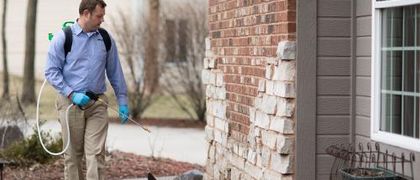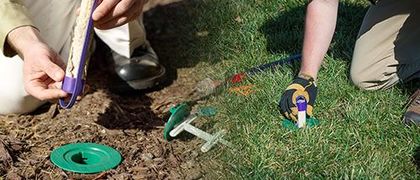How Cooler Weather Affects Pests
As the days get shorter and the temperatures drop, we cozy up inside our homes. Unfortunately, so do pests. Not surprisingly, we see an uptick in customer reports regarding bugs and rodents getting inside as cooler weather arrives, so we decided to take some time to tell you why this happens. In this blog post, we’ll explore why cooler weather drives pests indoors and share practical tips to help you keep them out. Plus, we'll explain how Miller Guard can provide extra protection to help homeowners in Des Moines, Kansas City, Omaha, and our Midwest service area stay pest-free in the fall—and all year. Let's jump right in.

Why cool days bring pests in
When it gets cold out, we bundle up in our favorite hoodies or sweaters to keep warm. Insects and rodents don’t have that luxury; instead, many pests look for a warm place to hide from the cold. Of course, there are always exceptions, and not all pests have trouble with the cold.
What do bugs do in the fall?
Insects are cold-blooded, so they don't regulate a consistent body temperature. Their bodies are at the same temperature as the air or soil around them. Since they can't regulate temperature, they can freeze. But long before they freeze, many insects start looking for warm places to congregate. This behavior is called thermotaxis. It drives them to start crawling on the sun-warmed sides of buildings, hiding under the bark of trees to shield themselves from the elements, and coming indoors.
- When an insect warms itself on your home's exterior, it is in the perfect location to find its way indoors.
- When an insect crawls underneath the siding, it can find rotted wood gaps and enter wall voids.
- When an insect crawls into a tiny sliver of a gap around a window frame, it can get into the frame void and possibly find a way into a wall void.
- When an insect crawls around in an entryway, it can feel warmth coming from gaps in weather stripping and door sweeps. These warm temperatures invite the insects indoors.
How spiders handle the fall weather
As mentioned briefly, some pests are well-equipped to deal with cold weather. Spiders are a great example. Some have a natural antifreeze that protects them from freezing, and they survive winter outdoors by hiding in woodpiles and other sheltered areas. They also enter a hibernation-like state known as diapause. Some species may not survive freezing temperatures, but their spiderlings in egg sacs can.
So, why do spiders come inside homes on cool days? They follow the insects. Spiders eat various insects, and when insects go into hiding, spiders get hungry. Their hunger brings them into your home on a cool fall night and the comfortable lodgings and ample food supply may keep them there.
Fall rodent activity in the Midwest
Rats and mice have fur to help them stay warm. They don't hibernate in winter and are often active on cold nights, braving the cold to find a meal. So, why do they tend to get into buildings in the fall?
While rodents are resistant to cold because they have fur, they are warm-blooded and tend to go where the temperatures are ideal. When temperatures start to cool, rodents know that winter is on the way. They will establish themselves if they find a food source inside a structure. They'll eat human food as well as bugs.
Some rodents prefer to live in structures even if they don't find a food source. A wall void is similar to a tree cavity or log, where they live in nature.
As you can see, fall is an important time of year to ensure your home is impenetrable to insects and rodents. This can save you the hassle of battling pests throughout the long winter.
How to keep pests out during cooler weather
Only a handful of factors motivate pests and bring them inside. Some are beyond your control. For example, you can't do anything about insects congregating on sun-warmed exterior surfaces. However, taking the time to address what you can control will impact pest activity near your home.
Remove attractants
Inspect your exterior and consider what would attract insects, spiders, or rodents to live near your home.
- Clean trash receptacles and keep all trash stowed and covered.
- Keep exterior lights off or replace white lights with yellow, insect-resistant lights.
- Remove leaves, branches, and other organic yard debris.
- Pick up old tires, tarps, wheelbarrows, and other items that offer shelter to pests.
- Trim vegetation to remove hiding places.
- Move bird feeders away from your exterior.
- Rake up nuts or fruit.
- Properly store outdoor patio furniture.
Eliminate moisture and water sources
Pests need water to drink and to maintain body moisture. Addressing dampness, humidity, and water sources will help reduce pest activity.
- Rake out your gutters to remove clogs and ensure downspouts divert water from the foundation.
- Repair damaged areas of your gutter system.
- Fix leaking spigots or exterior pipes.
- Apply gradation or a French drain to address puddles and pooling.
- Address indoor plumbing issues.
Seal entry points
Pests get into your home because they can. Everything you do to keep them out will help deter them.
- Replace damaged weatherstripping and screens.
- Caulk around door and window frames.
- Fill in gaps around pipes, wires, and other exterior wall penetrations.
- Apply vent covers or screens.
- Fill in structural cavities.
- Replace rotting wood.
Don’t forget to sign up for year-round home pest control!
You can get a lot done with your DIY pest prevention efforts. But, for extra protection or if you’ve already detected pest activity in your home or property, Miller Pest & Termite can help!
Miller Guard, one of our year-round home pest control plans, is designed to provide ongoing protection against pests, including insects, spiders, and rodents.
With Miller Guard, you'll receive regular inspections and treatments tailored to your home's needs. We use advanced techniques and eco-friendly products to create a protective barrier around your home, preventing pests from entering. It is an easy and stress-free way to keep pests out. Check out the plan details and pricing below, or give us a shout!
Ongoing Home Pest Control Recommendation
Miller Guard
Our signature Miller Guard pest control plan stands out in the industry by giving you Full Pest Coverage and Zero hidden fees. It is designed to eliminate and prevent insect and rodent problems by targeting pest entry and exit points for maximum effectiveness. It includes an initial premium interior application, exterior applications, web removal, and wasp nest removal.
- Ongoing Preventive Services
- 29 Pests & Services Covered
- Initial Premium Interior Application
- Exterior Applications
- Rodent Control
- Wasp Nest Removal
- Cob-Web Removal
- 1-Year Service Agreement
Starting at:
$4999A Month
Free Quote Or Call (515) 518-8864

Additional Miller Guard Details
Pests Covered: Asian Beetles, Boxelder Bugs, Carpenter Ants, Carpet Beetles, Centipedes, Clothes Moths, Drain Flies, Earwigs, Fleas, Fruit Flies, Grain Beetles, Hornets, House Ants, Indian Meal Moths, Mice, Millipedes, Pill Bugs, Rats, Roaches**, Silverfish, Spiders***, Stink Bugs, Wasps, Weevils, Yellow Jackets
Service frequency will vary based on geography. The Miller Guard program does not include the following pests: honey bees, flies, lice, dust mites, mosquitoes, exterior ticks, ornamental/turf pests, slugs, snails, termites, wildlife, birds, and brown recluse spiders.
- Pricing does not include initial fee
- Must have credit card on file
**American, German & Oriental
*** Venomous & Non-venomous
Stay ahead of the pests this fall
Cooler days mean pests will be looking for ways to get into your home in search of warmth, food, and shelter. With a few preventative steps—like sealing entry points, reducing clutter, and eliminating food sources—you can significantly reduce the chances of an infestation—and with our team of highly trained and fully licensed pest control specialists looking out for your home and family, you can rest easy this fall and all year long. Contact us today!
Get Help Now!










